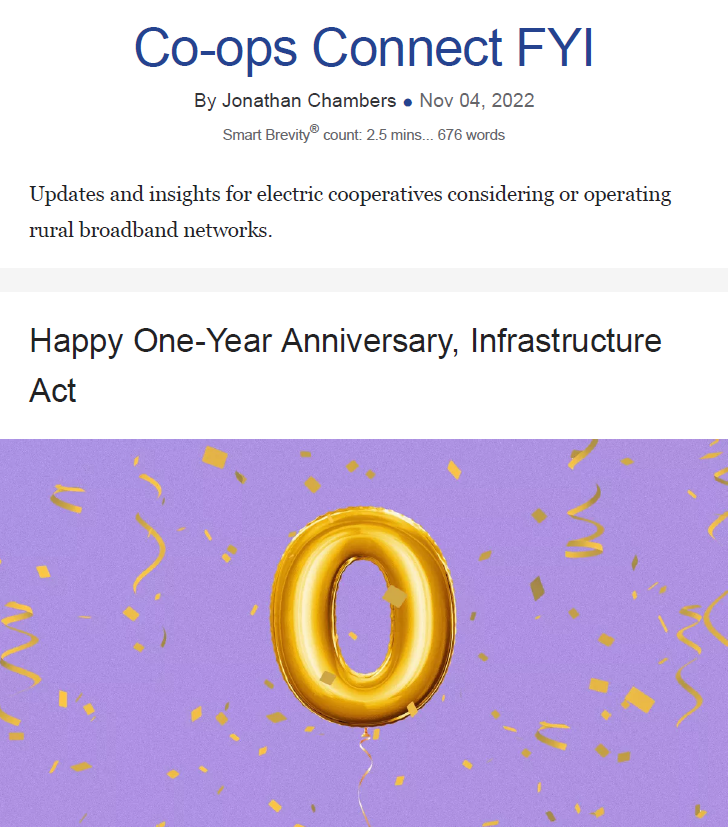Happy One-Year Anniversary, Infrastructure Act
November 4, 2022
Today’s newsletter marks a momentous occasion: The Infrastructure Investment and Jobs Act passed the House of Representatives one year ago, on November 5, 2021. (It was signed by the president on November 15, so I’m jumping the gun.)
Let’s grade the government’s work on using the $42.45 billion in BEAD funds to connect previously unserved and underserved households.
- How many previously unserved homes have received broadband using BEAD funds? Zero.
- How many previously underserved homes have received broadband using BEAD funds? Zero.
- How many miles of fiber-optic networks have been built using BEAD funds? Zero.
- How many homes passed with new fiber construction from BEAD- funded projects? Zero.
- At least the final new National Broadband Map has been published, right? Nope.
- Identification of high-cost areas? Nope.
The federal government agencies in charge of BEAD haven’t been sitting on their hands. They’ve been hard at work writing new rules and regulations.
- Are there lots of new federal requirements that will drive up the cost of construction and add inflationary pressure to the economy? Yup.
POTs and PANs blogger Doug Dawson recently asked whether the lack of progress was the result of some smoky back-room deal in Washington.
Nope. Not a conspiracy. Just federal bureaucracy.
- Even though Congress decided that $42.45 billion should be spent by state governments, not federal agencies.
- It is preternaturally difficult for a bureaucracy simply to let go.
The bottom line:
At the current pace, BEAD funds won’t create new broadband service until 2024 or 2025 at the earliest.
To quote Doug:
“We’ll be lucky if much actual construction is done in 2024 because even after a grant award is made, there will be a time-consuming process of completing all of the needed paperwork for a grant winner to receive the funding. After that, most grants are going to have another delay while environmental studies are done – something that is a huge waste of time and money for any network that will be constructed in existing public rights-of-way.”
The big question:
If Congress had been informed by NTIA in 2021 that it wouldn’t fund construction of broadband until 2024, I don’t think Congress would have given NTIA the job.
Instead, like CARES, Congress would have made funding directly available to states and counties.
So, can we change course and accelerate BEAD?
Accelerate BEAD
I’m going to put on my old Senate legislative hat and draft a new bill to gift to the incoming Republican Congress.
Call it the BEAD Acceleration and Inflation Reduction Act.
The provisions will include:
1. Within 30 days, NTIA shall calculate the allocation of funds to states and territories using the DATA maps available as of January 1, 2023 or the date of the calculation. All data used by the FCC and NTIA in determining unserved locations and calculating the allocation, including the underlying data, assumptions and methodologies, shall be made publicly available.
2. Within 30 days of a state request for BEAD funds, NTIA shall grant requests for the allocated amounts to any state that presents a broadband plan certified by the governor. NTIA shall have no discretion to deny funds for certified broadband plans.
3. To the extent any governor certifies that requirements imposed by NTIA, or any federal agency, will either delay the deployment of broadband or increase the cost of broadband construction, all such requirements shall be waived until the National Bureau of Economic Research reports that inflation has decreased below 2% for two successive quarters.
The bottom line:
That’s it. That’s the whole bill.
Get the money to the states. Let them get the money to companies constructing networks to unserved and underserved areas.
I look forward to working with a Republican or Democratic House members or Senators to accelerate broadband construction in rural America.
